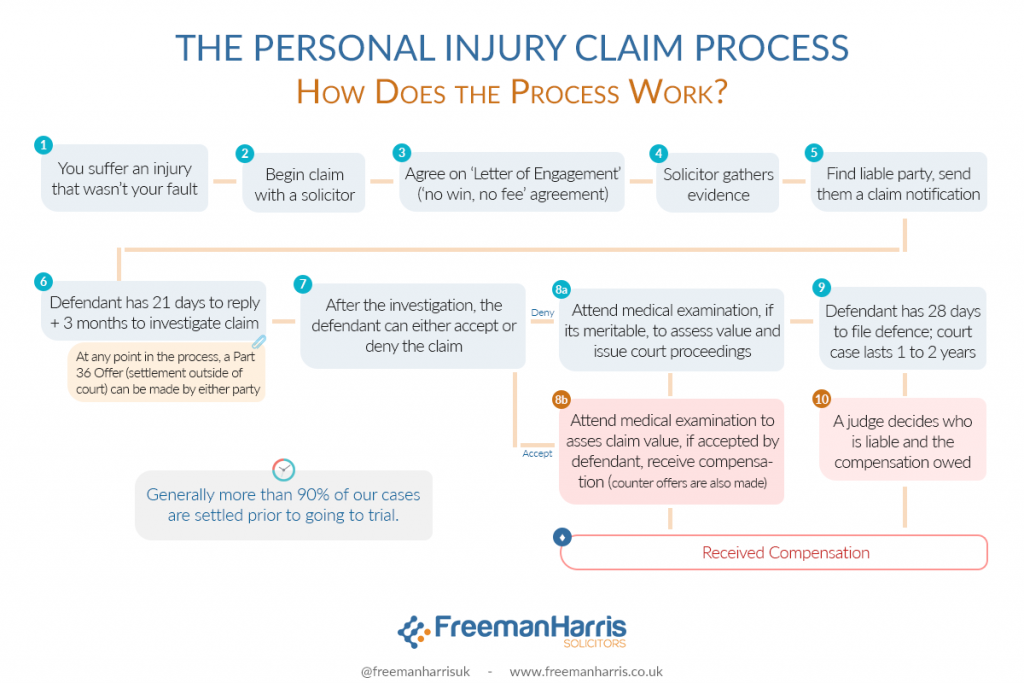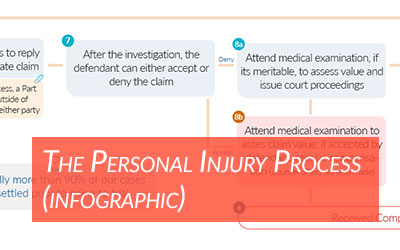
1. You suffer an injury that wasn’t your fault. The injury could be sustained at work, on the road or anywhere within the UK for that matter.
2. You chosen solicitor will start the claim process.
3. You and your solicitor will agree on a Letter of Engagement, which details how we will work for you. This letter is also called the CFA or the ‘no win no fee’ agreement. This means that you do not have to pay the legal costs of your solicitors and your solicitor will take a percentage of the compensation you receive.
4. Solicitor will investigate the matter and gather all evidence to make your case against the liable party.
5. Your solicitor will work out who is at fault in the claim. This is the person who is responsible for causing you the injuries; for example, it might be your employer if you suffered an injury at work or the fault of another driver if you suffered an injury on the road. Your solicitor will send the Defendant a claim notification letter.
6. The Defendant has 21 days to reply to the Letter of Claim, and then 3 months to investigate the claim themselves.
At any point in the process, either party can make a Part 36 Offer. This is an amicable offer of settlement that is outside of the courts and encourages parties to settle without a need for a trial. If you receive a Part 36 Offer, or wish to make one, we will advise you.
7. After their own investigation, the Defendant will do one of two things.
a) They accept the injury is their fault. Now your solicitor and the Defendant will talk about the cost of damages and how much settlement you are entitled to, which could fall under a Part 36 Offer.
b) The Defendant could deny liability, or only admit partial liability.
8a. If the Defendant admits liability, then we ask you to attend a medical examination in order to assess the value of your compensation. Don’t worry, you’ll get to see the report before it is disclosed and you are well within your right to ask for factual amendments. If you’re happy with the medical report then we send it to the third party (the party at fault) so they can review it and either accept your solicitor’s offer or make a counter offer.
8b. If the Defendant denies liability, then we’ll ask you to attend a medical examination if your Solicitors are confident of the merits of the case based on the evidence. Don’t worry: you’ll get to see the report before it is disclosed and you are well within your right to ask for factual amendments. We will then issue court proceedings. Issuing proceedings means we are moving your case to a court for a judge to decide the final outcome of the case. (Generally more than 90% of our cases are settled prior to going to trial.)
9. Once proceeding are issued, the Defendants have 28 days to file a Defence and all in all, the court process could take between 1 to 2 years to resolve, depending on the court’s schedule.
10. Settlement is often reached before the case comes to trial. However, in the rare event that a settlement is not reached, the case will go to court where a Judge will decide who is liable and how much should be awarded in compensation.
Receive your compensation!
Don’t forget that every case is different and every claimant’s needs are different too. If your case is complicated, it might not run as smoothly as this flowchart! We will always endeavor to keep you informed about the progress of your case so you can have peace of mind.

